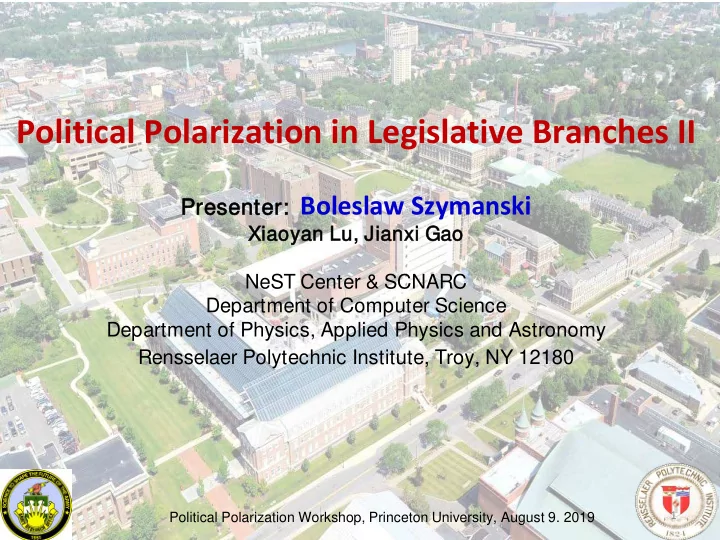

Political Polarization in Legislative Branches II er: Boleslaw Szymanski Pres esen enter Xiao aoyan an Lu, Jian anxi Gao ao NeST Center & SCNARC Department of Computer Science Department of Physics, Applied Physics and Astronomy Rensselaer Polytechnic Institute, Troy, NY 12180 1 Political Polarization Workshop, Princeton University, August 9. 2019
9 Dynamic Social Competition Model [1] measures the current polarization, so the collaboration is measured by the complementary fraction of x, i.e. increased competition lost competition simple symmetric transition functions: Perceived utility of competition, Impact of population = Evolution speed (the benefit fighting against the other belief on the change of party on certain bills) polarization [1] Abrams, D. M., & Strogatz, S. H. (2003). Linguistics: Modelling the dynamics of language death. Nature , 424 (6951), 900. Political Polarization Workshop, Princeton University, August 9. 2019
10 Dynamical Model for Polarization Evolution ➢ We assume a social system dominated by two parties. In such a system polarization and collaboration can convert into each other but they maintain their sum constant at 1. Stable Unstable system system
11 Dynamical Model for Polarization Evolution Stab able s e system em: Unstab able e sy syst stem:
12 Direction of Polarization Change ➢ When the initial polarization level (green cycles) is smaller than the stable polarization level predicted by our model (solid black curve), we observe an increase of polarization within one Congress. The direction of such change in 28 out of all 30 Congresses are explained by the model (green arrows) Political Polarization Workshop, Princeton University, August 9. 2019
13 Polarization Utility ➢ 6 of 14 Presidential election Congresses started with the polarization utilities at least 0.5 while only 1 of 15 midterm election Congresses achieved such high polarization utility ➢ The highest polarization utility growth (57.1% ) occurs in the 112th Congress (2011-2013). Super PACs arose following the July 2010 federal court decision Political Polarization Workshop, Princeton University, August 9. 2019
14 Structural Change of Competition among States The pairwise disagreements are at similar level while the structure of competition changes significantly. The order of states is ranked by their one-dimensional PCA projection. 95th Congress (1977-1978) 110th Congress(2007-2008) Political Polarization Workshop, Princeton University, August 9. 2019
15 Social Flocks Model (Extended Boids Model) The three rules of social flocks movement in latent space Z : 1. Separation : steer to the opposite direction of competitors 2. Cohesion : steer to move toward the average position of local flockmates 3. Gravity : steer towards the most neural position (origin) The Euclidean distance matrix A ij follows Gaussian with mean | Z i - Z j | 93th Congress 102th Congress 108th Congress Political Polarization Workshop, Princeton University, August 9. 2019
16 Competition Structure Matters The network structure of competitors impacts the final polarization level. We simulate the evolution of polarization using a competition graph generated by planted partition model with intra-group edge probability q and inter-group edge probability p . q=0.8, p=0.3 q=0.2, p=0.7 Polarization Political Polarization Workshop, Princeton University, August 9. 2019
17 Contributions Theo eory: We define a dynamical model qua uant ntifying ng the he evolut ution n of of pol polarization on in the U.S. Congresses elected in the past six decades. The hidden model parameter, polarization utility, correlates well with significant political or legislative changes happening at the same time. Alg lgorit ithm: We implemented a predictor based on the model that successfully predicts the direction of polarization changes in 28 out of 30 elected U.S. Congresses. The hidden model parameter, polarization utility, correlates well with significant political or legislative changes happening at the same time. Political Polarization Workshop, Princeton University, August 9. 2019
18 Thanks Questions? This work was supported by Army Research Office grant #WNF-15-0254 under the Program Manager Dr. Lisa Troyer Ref efer eren ence: e: X. Lu, J. Gao, B. K. Szymanski, “The evolution of polarization in the legislative branch of government,” Royal Society Interface , 16 :20190010, 2019 Political Polarization Workshop, Princeton University, August 9. 2019
Recommend
More recommend